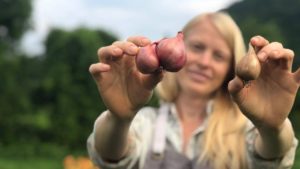We love to share what we love... and we love garlic and shallots! You'll find gorgeous seed garlic & shallots listed here every late Summer/early Fall. And don't forget the fertility... our Organic Garlic and Shallot Fertilizer has specially blended diverse amendments to feed both our soil and our alliums, and in turn, us!
Transcript: Shallots have earned a reputation and deservedly so of being sweeter than their pungent cousins, the onion. And they are in fact, so luscious and so much more sweet. And if you haven’t tried them, certainly growing them, I can’t recommend it highly enough. If you love growing garlic, they’re just that easy. They reproduce clonally some by seed, but mostly they reproduce clonally. So we’re going to be planting each of these in the fall and harvesting them all next summer. So but here’s a little bit more about shallots, because there’s lots of different varieties, and let’s break it down.
So, we have the true shallots, which are different genus species than onion, and then we have a lot of shallots. And anything that you’re going from seed is the same genus species Allium CEPA. As an onion, and even these large Dutch or French, the red type shallots, these are more closely related to multiplier onions. So they’re more mostly related to onions. So their flavor yes is sweeter than a classic onion, but it’s still not as sweet as the true shallot. I still love these because they’re so productive and they’re so beautiful. And they stored 12 plus months, which is just amazing. And so that’s important because the true shallots, these griselles, they are same genus different species than onions than these other multiplier onions, the red type shallots. These only you harvest them mid summer, just like garlic just like the red dot shallots, but they only store till about December. So they have a much briefer window for when you enjoy them, but their flavor is unparalleled. They are so much sweeter, they have very little sulfurous pungent compounds and as a result, they caramelize like a dream.
I grew up kind of caramelizing onions by putting a tiny bit of sugar on them, which is what a lot of restaurants do to faux caramelized onions. But these do it all by themselves because their sugar content is so high. And so as a result, you don’t need that many. If you want to have a pound of onion in your Ratatouille, go for an onion. Don’t use these you’d be there cutting all day but with we with five of these cut up and all of a sudden they’re transforming a meal literally the cherry on top, just and they are unspeakably divine. And so a little goes a long way.
And here’s what they look like when we’ll plant one of these in the fall. And all of a sudden we will have this glorious clump of shallots for the next season and we cure them just like garlic will store them just like garlic. And yes, you can always tell the true shallot because it has that lighter creamier bronze skin and it’s very rough By comparison, where and they look They’re always tapered, so they always they remind me of little ivory apostrophes, where the Dutch the red style shallots look more like miniature onions. And in fact they are like miniatures, sweet onions.
So there you have it, friends, some basic things to keep in mind when deciding your shallot future. And I hope that you try them both and aren’t and enjoy them both as we do.


